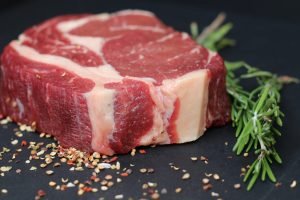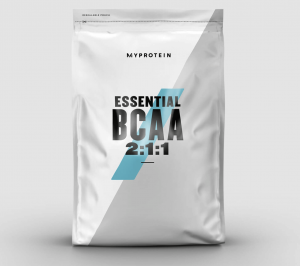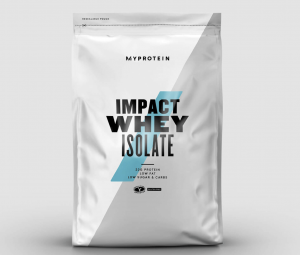You’re at a gas station and decide to get a quick protein snack. You have beef jerky on one hand and peanuts on the other, but which should you get?
As an athlete or someone who is looking to increase strength and muscle mass, you may be wondering what decisions you can take to get the upper hand. You typically want to look for a protein source that can increase muscle mass and reduce the amount of recovery time. Therefore, the most logical question you can formulate is, should I consume animal protein or plant protein?
Some people say that any protein is fine as long as you’re consuming protein in general, regardless of the source. Others, however, argue that protein sources vary among one another and there indeed is one superior than the other.
Before comparing both sources, let’s review the role of protein in the body.
What is protein?
Protein is one of the three macronutrients alongside carbs and fats that provide your body with the necessary energy in the form of calories.  At 4 calories per gram consumed, it remains the most favored macronutrient among most bodybuilders and athletes.
At 4 calories per gram consumed, it remains the most favored macronutrient among most bodybuilders and athletes.
Most people generally receive their protein from animal sources, however, due to other reasons such as personal beliefs and dietary restrictions other defer to plant protein.
How much protein should I consume?
Protein makes up about 15-20% of a person’s entire body weight. Since we are unable to store protein, it is crucial to get the required amount everyday from your diet.
It shouldn’t come as a surprise that an individual who lives a more sedentary lifestyle will require less protein than someone who trains 3-4 times per week.
Below is a table highlighting the Recommended Dietary Allowance for protein: [1]
Recommended Protein Intake | |
Sedentary Lifestyle | Active Lifestyle |
0.80 g per kilogram (kg) of bodyweight | 1.2-2.0 g per kilogram (kg) of bodyweight |
0.36 g per pound (lb) of bodyweight | 0.55-0.90 g per pound (lb) of bodyweight |
What does protein do?
A common misconception is that protein is only used for muscle growth, but this couldn’t be further from the truth. In fact, protein is responsible for various functions throughout the body.
When consumed, protein is broken down into amino acids through the help of stomach acid and enzymes known as proteases.
Amino acids are known as the “building blocks” of protein and their involvement in necessary in nearly every bodily function from growth, repair and digestion.
If the relationship between protein and amino acids is a difficult concept to wrap your mind around, think of amino acids coming together forming long beaded strings that fold into complex shapes. Each protein chain depending on the length and shape, will carry out a different function in the body.
Below are a few roles amino acids are responsible for:
- growth of muscle and other connective tissue
- healing and repair
- maintain normal digestion
- provide energy for body
- neurotransmitter production
There are 23 amino acids that the human body needs to survive and build proteins of its own. For the sake of the topic on hand, we will discuss the 20 standard amino acids and ignore the 3 non-standard. Each of the 20 individual amino acids falls into the essential or non-essential category.
Essential amino acids are those that must come from your diet in order for your body to function properly. The human body is also able to synthesize (produce) other amino acids, without having to obtain them through diet, and these are categorized as non-essential.
Essential: must come from diet
Non-Essential: synthesized in body
The human body needs 20 different types of amino acids that get converted into proteins that vary in size, shape and function. Unfortunately, your body is only able to produce 11 out of the 20. Since our bodies cannot produce the other 9, it is necessary to receive them from our diet.
ESSENTIAL (9) | NON-ESSENTIAL (11) |
histidine | alanine |
isoleucine | arginine |
leucine | asparagine |
lysine | aspartate |
methionine | cysteine |
phenylalanine | glutamine |
threonine | glycine |
tryptophan | ornithine |
valine | proline |
serine | |
tyrosine |
As important as amino acids are, the reality, however, is that different sources of protein contain different amino acids. The two main sources people generally receive their protein from are from plants and animals.
What is animal protein?
Animal protein, as the name implies, is the kind of protein derived from animals. Sources such as fish, meat, eggs and dairy are referred to as complete sources of protein as they provide the body with all 20 amino acids.

Animal protein sources:
- eggs
- fish
- red meat (beef, pork, lamb)
- dairy (milk, cheese, whey)
For a more comprehensive list click here.
Animal protein health benefits
There are numerous benefits to consuming animal protein aside from containing all 20 amino acids.
In fact, a study published in 2010 closely monitored 84,136 women ages 30-55 who were in good health. Researchers reported participants who consumed poultry, fish and low-fat dairy were at a lower risk of heart disease.[2]
Meat isn’t the only animal protein source with great health benefits. Incorporating eggs into your diet has also been linked to weight loss in a caloric deficit diet and improved cholesterol.[3] [4] Of course this can only be achieved when eating in moderation and maintaining a calorie deficit.
Aside from having all 20 amino acids, animal protein sources generally have a unique nutrient content that some plant sources may lack. [5] These nutrients include:
- Docosahexaenoic acid (DHA)
- Heme-iron
- Zinc
- Vitamin B12
- Vitamin D
Animal protein health risks
Despite being a complete source of protein with all 20 amino acids, certain animal sources can also potentially cause health problems.
Research shows, throughout several studies, that high consumption of processed red meat such as sausage and ham can increase risk of heart disease, strokes and cancer. [6][7]
Not all red meat is “bad” however. One study published in 2013 monitored 448,568 participants including health and diet. Results shows a significant increased risk of death in participants who consumed more processed red meat and no signs of increased risk in unprocessed red meat.[8]
It was previously thought that red meat increased cardiovascular disease, strokes and cancer, however, further research has confirmed unprocessed red meat is not correlated with heart disease.[9]
Processed red meat health risks have not been seen in other animal protein sources such as chicken, fish, and poultry. If you are at a higher risk of heart disease it would be wise to look for a better alternative such as unprocessed red meat or perhaps give plant protein a try.
What is plant protein?
Plant protein, on the other hand, can also provide us with amino acids but oftentimes lack one or more essential amino acid. Protein that comes from plant sources, however, can also provide their own unique set of nutrients that animal protein does not.
Some people may challenge this statement and mention soy as a plant protein source that contains all 20 amino acids. While this may be true, literature shows soy protein contains very small amounts of Lysine and Methionine which still makes it incomparable to animal protein in this regard.
Plant protein sources:

- Lentils
- Soy
- Chickpeas
- Quinoa
- Nuts
- Beans
For a more comprehensive list click here.
Plant protein benefits
A study published in 2011 closely monitored the diets and lifestyles of 120,877 men and women in the U.S. Results demonstrated throughout the study, a diet that included nuts as a major protein source was linked to weight loss.[10]
Consuming foods such as beans, chickpeas, lentils and peas have been found to contribute to acute satiety (feeling full).[11] Increasing satiety throughout the day can help prevent overeating and subsequently weight gain.
Plant protein sources are also known for their fiber content. Fiber plays an important part towards regulating your digestive system and maintain a healthy gut microbiota.
Additionally, plant protein sources are filled with nutrients specific to their sources such as phytonutrients which are chemicals produced by plants that offer antioxidants as well as anti-inflammatory benefits.
Animal protein vs plant protein: what works best?
Okay so lets stop beating around the bush and get to the point.
A healthy diet incorporates protein from both animal and plant sources, but to better answer this question optimally, you must know what your goals are.
Muscles are dynamic meaning they are constantly breaking down and being rebuilt. In order to build muscle, the amount of muscle protein being synthesized must be greater than the amount of protein that is being broken down.
If you are looking to build more muscle mass and speed up recovery, getting your protein from animal sources can would be the best option to pursue.
If your goal, however, is to incorporate protein into your diet while also reaping the health benefits of nutrient dense foods, plant protein sources might be your best bet. Remember you can still build the same amount of muscle mass with plant protein sources, however, it may take a bit more effort.
According to a study published in 2017, the amount of protein consumed mattered much more than the type of protein.[12] Again its encouraged to diversify your dietary protein intake, however, the amount or percentage you choose from either source is completely up to you and your individual goals.
Supplements to help get all amino acids
While it remains true that plant protein is deficient in certain amino acids, there are some supplements that can help you close the gap. Here at Pro Healthy Fitness, we will always encourage all your nutrients to come from whole foods, but recognize everyone’s lifestyle and daily demands can vary from person to person.
BCAAs
BCAA’s (Branched Chain Amino Acids) are supplements that contain 3 essential amino acids. These 3 amino acids are Leucine, Isoleucine and Valine. When combined, they play a vital role in muscle recovery.
Several studies have shown BCAA’s, especially Leucine, to increase muscle growth by stimulating/increasing the rate of protein synthesis and decreasing the rate of protein degradation. Essentially BCAA’s can help promote the active process of building muscle while reducing the rate at which resting muscle breaks down.
Additionally BCAA’s can decrease the soreness achieved after a workout. The soreness, also known as delayed onset muscle soreness (DOMS) can develop anywhere from 12 to 72 hours after intense exercise. By reducing the amount of muscle damage, BCAA’s are also able to decrease the amount of time and severity of soreness.[13]
You can reap the benefits of BCAA’s especially if you’re not consuming the adequate amount of protein, but by no means should this be a permanent replacement to a high protein diet. In fact, taking BCAA’s by themselves is a poor strategy to building muscle mass and I would even go as far as saying they are not necessary if your protein consumption is adequate.
Pro Healthy Fitness’s BCAA recommendation, click here.

Soy (plant protein)
Soy protein is a another great plant protein option especially if you are vegan or vegetarian. As a complete protein with all 20 amino acids, it must be combined with other sources of protein throughout the day to ensure greater muscle protein synthesis. [14]
Pro Healthy Fitness’s soy protein recommendation, click here.

Whey (animal protein)
Whey protein is oftentimes the preferred protein option due to the body’s ability to easily break down and absorb. This gives a significant comparative digestive advantage over sources such as meat or starchy plant protein foods. Many individuals prefer whey protein since its an complete source that provides all 9 essential amino acids and can usually be combined with other ingredients to produce a more nutrient-dense drink.
Pro Healthy Fitness’s whey protein recommendation, click here.

PHF on the subject
Whether your goal is to build muscle or maintain a proper diet, adequate protein consumption remains a critical component to your fitness goals and overall general health. Although it may seem like animal protein is the best source for muscle recovery, protein is not the only nutrient required to maintain overall health.
For this reason it is recommended that your diet incorporates protein from both animal and plant sources. Personally, my protein consumption is roughly 80% animal and 20% plant.
Again, the protein source isn’t exactly all that important relative to how much is actually consumed. If you do decide to simply have your protein come from one source completely over the other, that’s perfectly okay. There are no major health risks of simply choosing animal or plant protein, with the exception of processed red meats.
Like always, if you have any other concerns regarding your protein source choices and circumstances that affect your health, Pro Healthy Fitness always recommends to talk to your primary care provider.

